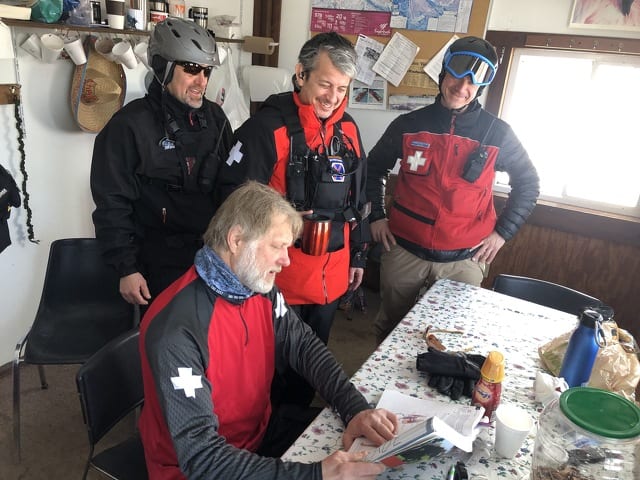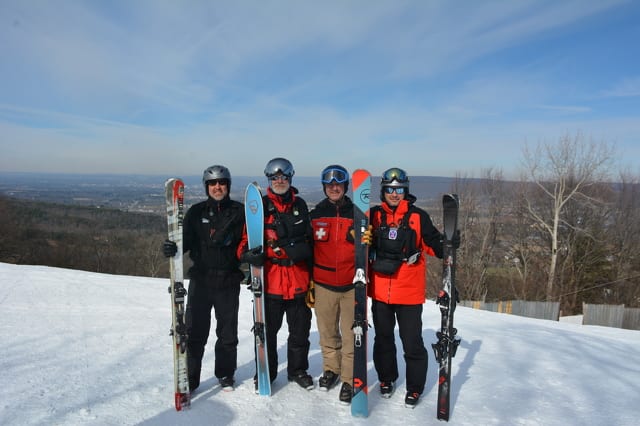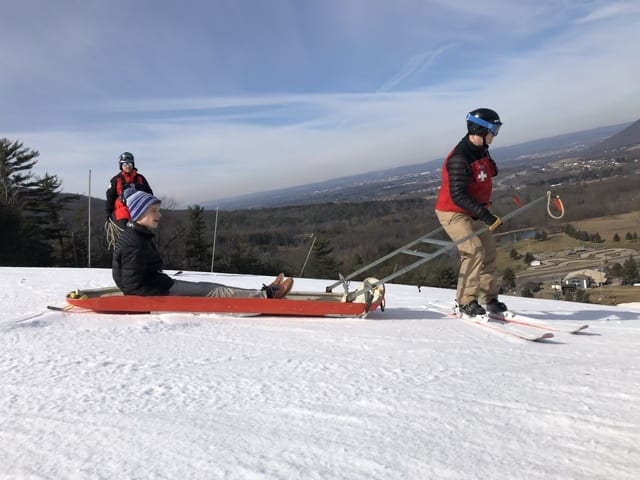This winter it may have felt a little warmer than expected, but up on the slopes of Tussey Mountain, the snow has been in good shape to ride, and all winter long the ski patrol has been monitoring the slopes prepared to respond at a moment’s notice to help injured skiers and snowboarders to safety.
Keeping those cold-weather recreation lovers safe is important. After all, sliding down a steep, snowy mountainside can be dangerous, and when something goes wrong, it is imperative that help can get there fast.
“Our basic job is that we are trained in the assessment and the stabilization, packaging and transport of any injuries in the outdoor environment,” said longtime pro ski patrol member Joe Horvath. And that means skiing down the mountain, sometimes in heavy snow storms, down difficult terrain, in order to make a rescue.
“Being able to help people in a really hairy, sticky situation, to get them safely off the mountains, that is what we are doing,” said Horvath. “People who we help went from having the most fantastic day on the mountain to being the worst day in a matter of seconds. When an accident happens, it is our job is to get down there and help relieve the anxiety and issues of what is happening.”
But even with the “really, hairy, sticky situations,” the ski patrol is a labor of love for the crew of snow enthusiast who work to keep the slopes safe for all, and there are many perks that come with the job — namely skiing — after all, that is their job.
Tussey’s ski patrol gets to open the mountain every day, meaning they are the first ones to lay track in the new and fresh snow. Other perks include lift passes and discounts when patrol members visit other nearby resorts.
“Every day is great on the mountain. You get to ski in all types of conditions,” said Horvath. He has been part of ski patrol for decades, and since he retired from his day job recently, he is up on the mountain as often as possible.
“That is the difference between us and other ski professionals,” Horvath said. “We have to go where everyone else fears to tread.”
Tussey Mountain Ski Patrol is a nonprofit organization providing emergency response and is National Ski Patrol and Professional Ski Patrol Association affiliated. The National Ski Patrol boasts more than 30,000 members from more than 600 patrols around the country, and is one of the largest outdoor safety organizations in the country. The crew up on Tussey is 48 members deep.
Patrol members are broken up into two categories — pro and volunteers — with the pro group getting paid to work the daylight hours on the mountain and volunteers work the nights and weekends. During the day, there are typically three pros on board and at night, Tussey runs with seven to eight volunteers. But for the most part, the people are interchangeable. Horvath said it just depends on who can work which shifts.
PREPARED FOR ANYTHING
Sitting in The Roost, the ski patrol’s shelter, high atop the mountain above the slopes, the crew is usually nice and toasty, sipping coffee on a sunny winter day, but there are times when it is not so pleasant in the small cabin.
“Some days there is three to four inches of snow and ice on the window and you can barely see anything, and the wind is whipping around at 30 miles an hour and you are just sitting, waiting and ready to go,” said Horvath.
On a typical day, one of the crew members is sitting in The Roost ready to respond with a toboggan to transport an injured skier, while the rest are skiing the slopes, on the lookout for hazards. They may be extra observant of a youngster who looks like they are skiing for the first time and will keep an extra eye on them, or follow a ski team from the high school down the slopes to make sure everyone is safe. A big part of the job, said Horvath, is anticipating where a problem could occur.
“You just have to be prepared for anything. We are skiing, looking for hazards and, in the event there is someone injured, we respond to that and the first aid training kick into gear,” said 9-year ski patrol member Aaron Potzner. “You never know what you are going to find. Typically, it might be a shoulder injury, an arm injury, knee injury, and basically what we are doing is a patient assessment … stabilizing. So we find someone, and in the event it is a head injury or back injury, we put them on a backboard. We carry all that stuff in the toboggan.”
It is no easy task to get an injured person off the mountain, and it is impressive to see the patrols negotiate the toboggan down the steep slope. A crew member in the front and one in the back work the sled gracefully down the grade, guiding it smoothly to level ground. Patrol members agree that it takes a lot of strength and skill on skis to do it safely.

Up in The Roost at Tussey Mountain, Joe Horvath goes through a ski patrol training manual with patrol members Bennett Hoffman, Rob Griggs and Aaron Pontzer. Photo by Vincent Corso | The Gazette
CHAIR LIFT RESCUE
The crews get a multitude of trainings, from first aid and CPR to ski training, so they can make it to injured people on the mountain. The crew at Tussey has earned a bit of ski patrol fame for having performed a chair lift evacuation after the lift malfunctioned on opening day in December 2018.
Ski patrols train for the procedure twice a year, but not many have had to perform the operation, and although it was a difficult day, Horvath said the crew at Tussey performed well, followed their training and prevented further injuries.
That day, a mechanical malfunction caused a chair slip leaving five chairs crammed together full of recreation seekers near the top of the mountain, on a very step section below the lift. With the help of the Boalsburg Fire Department and Tussey Mountain Outfitters, the crew was able to get all the people down as safe as possible.
“You go through that training and you hope you never have to use it … there was a lot of people that day and the lifts were full,” said Potzner. He wasn’t on shift that day, but was called in because other ski patrol members were on the lift. “I was like, ‘oh my goodness, now we have to do this for real with the public up there.’ I think it worked out as well as it could. In about two hours we had everyone down.”
“It is an event that you train for ad nauseam, and there are some patrols who will never go through an active chair evacuation, but now we have done it,” said Horvath.
“Everywhere I go, people are like, ‘Tussey Mountain … you had that chair lift evacuation.’ Everybody remembers it,” said Potzner.
Horvath said even as far away as the state of Colorado, people bring it up.
The crew credits the management at Tussey Mountain for fixing the problem quickly and getting things back in safe working order promptly after the accident.

“This our office,” said ski patrol veteran Joe Horvath while standing with fellow patrol members. Pictured, from left, are Bennett Hoffman, Horvath, Aaron Pontzer and Rob Griggs. Photo by Vincent Corso | The Gazette
AMBASSADORS OF THE MOUNTAIN
Rob Griggs is in his second year with the patrol, so he is still learning from seasoned pros like Horvath and Potzner. But he is enjoying his time on the mountain.
“What I like about what we do here is that we are small, but we are prepared, and the other thing that we do, from what I’ve learned, is that we are kind of like the ambassadors of the mountain too, so we are always out and we are always skiing, and when someone falls we don’t need to scare you and come up to you and overreact, but we can help you up. We can walk people down if they are just not feeling comfortable. We can make people feel better about the people from Tussey and let them know the ski patrol is a group they can trust. So, if something were to happen, than we can build up some credibility,” said Griggs. “It is one of the best feelings when you go up to a kid who has fallen, or an adult, and you help them get down the hill. Those are the things that make you feel really good about it.”
“We are not the cops. People seem to think we are like highway patrol, but we are not cops. We are rescue personal,” said Horvath.
“One of the things is that we always kid around about is that you could be very irritated by some of the shenanigans that goes on, but you are not helping anybody out if you are irritated. As long as they are safe and not a harm to anyone else, you have to let them have fun,” said Griggs. “But I also think how you talk to people is important, because we want them to enjoy it, and we don’t want to sit there and be the grumpy old dudes or ladies. We don’t want to be the judgmental ski experts because there are way better skiers out there.”
“It is great, especially here at Tussey Mountain, because we have a great crew. You get to ski a lot — a lot more than I was before doing this,” said Pontzer. “It is just great to be a part of the mountain … part of Tussey. This is a great place we have here. I think it is a gem in Centre County. It is a small local mountain, so you get to know the people well, from the other employees to the people skiing here all the time to the school groups that come out every day of the week.”
Horvath said Tussey Mountain is a pretty special ski hill because being in a college town, it is a place where many people learn to ski for the first time, and Horvath said, “You always remember the first place you ski.”
CHANGING CONDITIONS
How many rescues they perform in a day is determined by a lot of factors — the conditions, the weather, the ability of the skiers on the mountain — and the patrols do a lot a observing and communicating to help keep things safe.
“Ski areas change daily as far as conditions, and conditions can make something nice and safe or you can have pretty treacherous stuff when you have ice and rain,” said Horvath. “So it is a whole bunch of variables that determine if you have a few accidents, a whole bunch of accidents or just minor stuff.”
And they have to be prepared to be ready for rescue in all conditions, so Horvath recently sent Griggs down an icy run to test the conditions.
“There is nothing that can prepare you for that. I don’t care how good of a skier you are and there really wasn’t anybody skiing, and I remember looking like “why do I want to do this?,’” said Griggs with a laugh. “By the end of the run, I was convinced this wasn’t a sane thing to do, but I was convinced that if you are going to ski on the sunny beautiful days you have to ready to do down on Thursday nights on the ice humps, even if there is no one out there because that is what you signed up for.
“But it really got me to understand how I would respond if something would happen. How would I get a sled? How would I stop it on the ice? How would I treat an injured person?” said Griggs.
But it is all worth it for ski patrol members — after all they love the snow, the mountain and, of course, their crew. Horvath stood and stretched his arms wide to show the entire mountain seemingly in his embrace.
“This is our office,” he said. “Can’t beat that.”
Anyone interested in joining the ski patrol can contact director Ted Hovermale at tfh7381@gmail.com.



